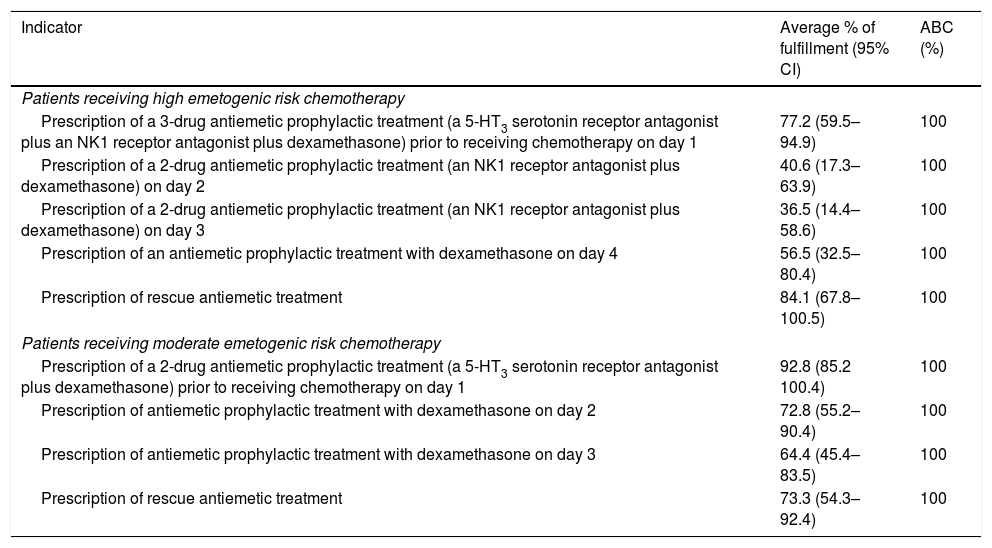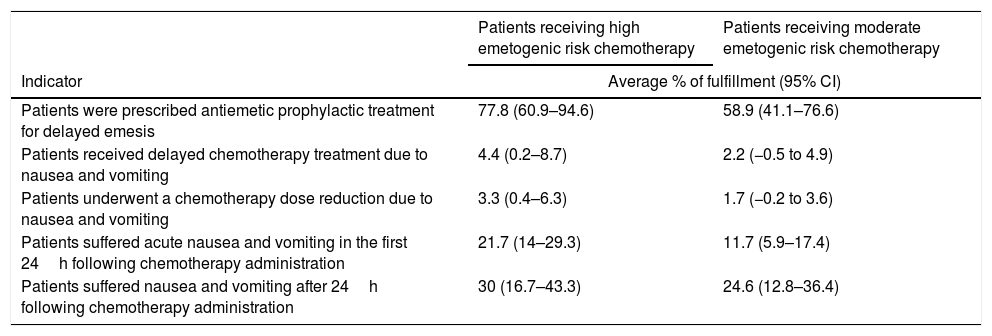To characterise current management of chemotherapy-induced nausea and vomiting in Spain, as well as professional adherence to antiemetic guidelines.
Materials and methodsRetrospective observational study. A multicenter has been designed including 360 patient case files from 18 hospitals. The involvement of pharmacists and nurses was studied, and also indicators of structure, process, and selected outcomes previously recruited from antiemetic guidelines.
ResultsWe found 94.4% of hospitals used a written protocol for managing chemotherapy-induced nausea and vomiting and only 44.4% had educational programs for patients regarding this. Patients were prescribed antiemetic prophylactic treatment for delayed emesis in varying degree between highly and moderately emetogenic chemotherapy (77.8% and 58.9%, respectively). Dexamethasone was the most prescribed antiemetic drug for patients receiving highly and moderately emetogenic chemotherapy (98.3% and 90%, respectively), followed by ondansetron (68.9% and 95%, respectively). Nursing was more involved than pharmacy units in evaluating emetic risk factors in patients (64.7% vs 21.4%), and tracking symptom onset (88.2% vs 57.1%) and adherence to treatment (94.1% vs 28.6%). Pharmacy units were more involved than nursing in choosing the antiemetic treatment (78.6% vs 47%).
ConclusionsAlthough antiemetic guidelines were used by all hospitals, there were differences in management of chemotherapy-induced nausea and vomiting. Increased education directed towards patients and oncology professionals is needed to improve adherence.
Caracterizar la gestión actual en España de las náuseas y vómitos inducidos por quimioterapia y la adherencia profesional a las guías de antiemesis.
Material y métodosEstudio multicéntrico y observacional con análisis retrospectivo de los datos. Incluyó la información de 360 historias de pacientes de 18 hospitales. Se estudió el papel de enfermería y farmacia, y también varios indicadores de estructura, proceso y resultado extraídos previamente de las guías clínicas.
ResultadosEl 94,4% de los hospitales seguía un protocolo escrito para el manejo de las náuseas y vómitos inducidos por quimioterapia; el 44,4% tenía programas educacionales sobre este tema dirigidos a pacientes. La prescripción de profilaxis antiemética para emesis retardada varió entre quienes recibieron quimioterapia de alto o moderado riesgo emetógeno (77,8 y 58,9%, respectivamente). La dexametasona fue el antiemético más prescrito a pacientes que recibieron quimioterapia de alto o moderado riesgo emetógeno (98,3 y 90%, respectivamente), seguido de ondansetrón (68,9 y 95%, respectivamente). Las unidades de enfermería estuvieron más involucradas que las de farmacia en la evaluación de factores de riesgo asociados con la emesis en pacientes (64,7 vs. 21,4%), la monitorización de los primeros síntomas (88,2 vs. 57,1%) y el control del cumplimiento del tratamiento (94,1 vs. 28,6%). Las unidades de farmacia estuvieron más involucradas que las de enfermería en la elección del tratamiento antiemético (78,6 vs. 47%).
ConclusionesPese al uso de guías de antiemesis en los hospitales, se encontraron diferencias en la gestión de las náuseas y vómitos inducidos por quimioterapia. Es necesario un mayor énfasis en la educación de pacientes y profesionales oncológicos para mejorar el cumplimiento del tratamiento.









